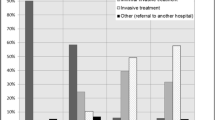Abstract
Although numerous etiologic risk factors have been proposed, the pathogenesis of hemorrhoids remains unknown. The present investigation assesses the temporal distribution of hemorrhoids as depicted by physician visits, hospital discharges, and surgical procedures to provide further insight into potential etiologic risk factors. The analysis was based on five data sources: from the United States, the National Disease and Therapeutic Index (NDTI), the National Hospital Discharge Survey (NHDS), and the Commission on Professional Hospital Activities (CPHA); from England and Wales, the Morbidity Statistics from General Practice (MSGP) and the Hospital In-patient Enquiry (HIPE). Results demonstrated a consistent decline in all data sources from the United States. The decrease occurred in males and females similarly and was most striking in those aged 45–64 years. Physician visits and hospital discharges for hemorrhoids in England and Wales likewise declined although the decrease was not as dramatic. The consistency of the temporal distributions among the two countries, as well as among the different sources, suggests that the observed decline may, in fact, reflect an overall decrease in the occurrence of hemorrhoidal disease.
Similar content being viewed by others
References
Hyams L, Philpot J. An epidemiological investigation of hemorrhoids. Am J Proctol 1970;21:177–93.
Burkitt DP, Graham-Stewart CW. Haemorrhoids— postulated pathogenesis and proposed prevention. Postgrad Med J 1975;51:631–6.
Burkitt DP. Varicose veins, deep venous thrombosis, and haemorrhoids: epidemiology and suggested aetiology. Br Med J 1972;2:556–61.
Burkitt DP. Hemorrhoids, varicose veins, and deep vein thrombosis: epidemiologic features and suggested causative factors. Can J Surg 1975;18:483–8.
Graham-Stewart CW. What causes hemorrhoids? A new theory of etiology. Dis Colon Rectum 1963;6:333–44.
Wannas HR. Pathogenesis and management of prolapsed haemorrhoids. J R Coll Surg Edinb 1984;29:31–7.
Johanson JF, Sonnenberg A. The prevalence of hemorrhoids and chronic constipation: an epidemiologic study. Gastroenterology 1990;98;380–6.
Gibbons CP, Bannister JJ, Read NW. Role of constipation and anal hypertonia in the pathogenesis of haemorrhoids. Br J Surg 1988;75;656–60.
Prasad GG, Prakash V, Tandon AK,et al. Studies on etiopathogenesis of hemorrhoids. Am J Proctol 1976;27:33–41.
World Health Organization. The International Classification of Diseases, 9th revision. Clinical modification, 2nd ed. DHHS Pub. No. (PHS) 80-1260. Public Health Service. Washington, DC: U.S. Government Printing Office, 1980.
Royal College of General Practitioners. Morbidity statistics from general practice: first national study 1952–53. Office of Population, Censuses and Surveys, Department of Health and Social Security. Government Statistical Service. London: Her Majesty's Stationery Office, 1958.
Royal College of General Practitioners. Morbidity statistics from general practice: second national study 1971–72. Office of Population, Censuses and Surveys, Department of Health and Social Security. Series SMPS No. 36. Government Statistical Service. London: Her Majesty's Stationery Office, 1979.
Royal College of General Practitioners. Morbidity statistics from general practice: third national study 1981–1982. Office of Population, Censuses and Surveys, Department of Health and Social Security. Series MB5, No. 1. Government Statistical Service. London: Her Majesty's Stationery Office, 1986.
U.S. Bureau of the Census. Current population reports. United States population estimates, by age, sex, and race: 1980 to 1987. Series P-25, No. 1022. Washington, DC: U.S. Government Printing Office, 1988.
U.S. Bureau of the Census. Current population reports, state population and household estimates to 1985, with age and components of change. Series P-25, No. 998. Washington, DC: U.S. Government Printing Office, 1988.
Kahn HA, Sempos CT. Statistical methods in epidemiology. New York: Oxford University Press, 1989.
Smith LE. Hemorrhoids: a review of current techniques and management. Gastroenterol Clin North Am 1987;16:79–91.
Bingham S. Dietary fiber intakes: intake studies, problems, methods and results. In: Trowell H, Burkitt D, Heaton K, eds. Dietary fibre, fibre-depleted foods and disease. London: Academic Press, 1985:77–104.
U.S. Bureau of the Census. Statistical abstract of the United States: 1984. 104th ed. Washington, DC, 1983:33–63.
References
Johanson JF, Sonnenberg A. The prevalence of hemorrhoids and chronic constipation: an epidemiologic study. Gastroenterology 1990;98:380–6.
Alexander-Williams J. Causes and management of anal irritation. Br Med J 1983;287:1528–9.
Smith RC, Greenbaum DS, Vancouver JB,et al. Psychosocial factors are associated with health care seeking rather than diagnosis in irritable bowel syndrome. Gastroenterology 1990;98:293–301.
Haas PA, Haas GP, Schmaltz S, Fox TA Jr. The prevalence of hemorrhoids. Dis Colon Rectum 1983;26:435–9.
Hyams L, Philpot J. An epidemiological investigation of hemorrhoids. Am J Proctol 1970;21:177–93.
National Center for Health Statistics. Ambulatory care survey, 1985.
National Center for Health Statistics. Health interview survey, 1985.
National Center for Health Statistics. Detailed diagnoses and surgical procedures for patients discharged from short-hospitals. United States, 1979. DHHS publication No. (PHS) 1274-1.
Barker DJ. Rise and fall of western diseases. Nature 1989;338:371–2.
Smith LE. Hemorrhoids: a review of current techniques and management. Gastroenterol Clin North Am 1987;16:79–91.
Author information
Authors and Affiliations
About this article
Cite this article
Johanson, J.F., Sonnenberg, A. Temporal changes in the occurrence of hemorrhoids in the United States and England. Dis Colon Rectum 34, 585–593 (1991). https://doi.org/10.1007/BF02049899
Issue Date:
DOI: https://doi.org/10.1007/BF02049899




